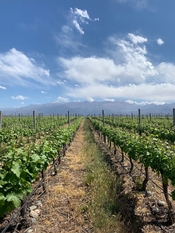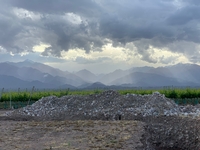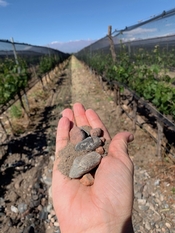 amounts of brawny, fruity, oaky wines sent en masse at lean prices to American retail shelves. For better or worse, commodity Malbec became a trend, much like the commodity Shiraz from Australia in an earlier period. But just as Australia has clawed its way back in international status with more nuanced wines spotlighting specific terrors and regions, so also is Argentina redefining Malbec and its profound potential in specific settings. Case in point…the Uco Valley.
amounts of brawny, fruity, oaky wines sent en masse at lean prices to American retail shelves. For better or worse, commodity Malbec became a trend, much like the commodity Shiraz from Australia in an earlier period. But just as Australia has clawed its way back in international status with more nuanced wines spotlighting specific terrors and regions, so also is Argentina redefining Malbec and its profound potential in specific settings. Case in point…the Uco Valley.
Located about an hour south of Mendoza city, the Uco Valley’s happy location nestled up in the front range of the Andes Mountains has made it a sought-after region for many of the country’s top producers. Claiming about 18% of Mendoza’s overall plantings, the Uco Valley is a relatively recent development, dating back to the late 1990s when trailblazers such as Catena, Clos de los Siete, Domaine Bousquet, Piedra Negra, Salentein, and Zuccardi started to explore the region.
They took one look at this remote, desert landscape cozying up to the Andes and saw potential. More than that, actually. Considering the area had very little infrastructure other than a few dusty, rock-laden backroads, no electricity, struggling communities, and infertile soils, it would be more appropriate to say these pioneers had true vision. Of course, back then, most people thought that vision was crazy. But as with most great successes that started based on a hunch, today, their foresight is considered pure genius.
I was recently hosted by a special collaboration of Uco Valley producers including Domaine Bousquet, Salentein, and Bodega Piedra Negra for a week-long visit, and had a chance to dig deeper into the region. As it turns out, the key to the success of the area is indeed its mountain territory, which ensures freshness, quality and diversity of styles for red and white wines alike. But there’s really much more to it. Without visionary pioneers, such as the ones mentioned above, it is doubtful that Malbec’s potential—or the myriad top-notch wines made from other varieties—would even be getting a second look. Based on this recent experience, perhaps it’s time to recognize that the wines of the Uco Valley are earning their moment in the high-altitude sun.
Here are 5 Takeaways from a week in the Uco Valley:
Land, Air, Water
Perhaps the most obvious defining feature about the Uco Valley is that large stretch of mountains looming along its western border. At altitudes ranging between 2,800 and 5,300 feet above sea level, the Uco Valley is the highest of Mendoza’s five growing zones. Altitude affects actual temperature, which in the upper reaches, can easily be 30°F cooler than in warmer Mendoza lowland zones. As the area also sits in the rain-shadow of the Andes mountains and more than 650 miles from the Atlantic Ocean, the air throughout the region is generally cool and bone dry. Here, winters are harsher, and summer days would be hotter were it not for the mitigating factor of altitude.
These conditions, combined with more than 300 days of direct sunshine, means vines stay healthy and rot-free. (In fact, this region is ideal for organic viticulture, which is taking more of a hold among producers including Domaine Bousquet, the first 100% certified organic producer in the region.) The use of un-grafted rootstock is also an option many producers have embraced.
Low fertility, low-nitrogen soils lead to lower yields and richly flavored fruit. The largest challenges to the region are the warm and destructive Zonda Winds which descend from the Andes, plus hailstorms and a frequent lack of water. Particularly in the last 10 years, snow fall in the Andes has been decreasing, resulting in less run off into the valley. While most producers have drilled wells to reach the water table, and can use controlled irrigation for their vineyards, laws are now in place to prevent further drilling for wells, putting a permanent cap on additional vineyards to be planted in the region.
Zeroing Down into Sub-regions is Key
Increasingly focused on “micro-terroirs,” progressive Uco Valley producers are leaders in research and development, reshaping the country’s appellations, and breaking new ground with their own styles and wines. Argentina’s appellations—known as Geographical Indications (GIs)—have become increasingly important for reflecting the diverse character of Argentine viticulture. The Uco Valley is home to three integrated departments including Tunuyán, Tupungato and San Carlos, each of which have an increasing number of GI’s ,the more prominent being Los Chacayes, San Pablo and Vista Flores in Tunuyán, Gualtallary in Tupungato, and Paraje Altamira and La Consulta in San Carlos. These are a few into which we dug a little deeper:
Gualtallary – Though not an official GI (yet), the Gualtallary is located in the Tupungato department, which has the largest area of vineyards in the Uco Valley (about 9,900 hectares). The Gualtallary is in a high-altitude corner of  the Tupangato that has garnered a reputation for being home to some of the region’s most highly sought-after vineyard area. With 2,470 hectares under vine, Gualtallary is a just a bit larger than Bordeaux’s St. Julien and is home to some of the most expensive farmland in Mendoza. Grapes from Alto Gualtallary are especially sought after by Argentina’s top winemakers. Here the soils are dominated by sand. In some vineyard parcels, you’ll find layers of caliche rock and in others, myriad alluvial rocks commingle with the sand. It’s the sand that allows excellent drainage for the vines and encourages their roots to dig deep in search of moisture. Wines, particularly red, take on a uniquely meaty character similar to the iodine/charcuterie characteristics of Syrah and Sangiovese.
the Tupangato that has garnered a reputation for being home to some of the region’s most highly sought-after vineyard area. With 2,470 hectares under vine, Gualtallary is a just a bit larger than Bordeaux’s St. Julien and is home to some of the most expensive farmland in Mendoza. Grapes from Alto Gualtallary are especially sought after by Argentina’s top winemakers. Here the soils are dominated by sand. In some vineyard parcels, you’ll find layers of caliche rock and in others, myriad alluvial rocks commingle with the sand. It’s the sand that allows excellent drainage for the vines and encourages their roots to dig deep in search of moisture. Wines, particularly red, take on a uniquely meaty character similar to the iodine/charcuterie characteristics of Syrah and Sangiovese.
San Pablo – Located in the highest elevations in the northern part of the Tunayán, the San Pablo GI literally received its official status a few weeks ago, and with much distinction. It is also one of Mendoza’s extreme regions in terms of altitudes, with vineyards planted between 3,600 ft (1,100m) and 5,600 ft (1,700m) above sea level. Its name corresponds to Estancia San Pablo, a Jesuit mission established there towards the 17th Century, according to Wines of Argentina. San Pablo is located on the alluvial fan of the Las Tunas River, on the right bank, consequently the soil has a high pebble content as well as other calcareous materials. Perhaps due to its plantings at higher elevations, the wines from this region tend to show more delicacy, refined structure, and floral aromatics.
Chacayes – In the Tunuyán department, the second largest in the Uco Valley, the Chacayes GI sits right in the mountains. The majority of the soil composition here is rocks, rocks, and more rocks. In this specific GI, the soils are made from a series of alluvial fans washed out from the Cordillera de los Andes (Andes mountain range). These poor, sandy-loam soils are interlaced with a mixture of granite, basalt, and metamorphic rocks (primarily rounded from river erosion). In some locations, such here at Bodega Piedra Negra, the rocks range around soft-ball size. But in other parts of the GI, some boulders are found with diameters of more than a meter. The prevalent presence of calcium carbonate deposits on the stones and in the soil continue the thread of structure and mineralogy expressed in the wines of Uco Valley’s higher elevation site. (Los Chacayes elevations range between 1000 and 1400 meters above sea level. (3,200-4,600 ft.) The area does not suffer a great inclement weather. There is almost no hail nor frosts, although there is intense cold and a high thermal amplitude. The maximum temperatures during the summer months easily exceed 30ºC (86ºF) and go down to 5ºC (41ºF) during the night. The stony fields in which the vines are planted in this GI, seem to have an effect on the overall structure of these wines. They are fresh, but grippy, with a common aromatic thread of wild thyme.
are made from a series of alluvial fans washed out from the Cordillera de los Andes (Andes mountain range). These poor, sandy-loam soils are interlaced with a mixture of granite, basalt, and metamorphic rocks (primarily rounded from river erosion). In some locations, such here at Bodega Piedra Negra, the rocks range around soft-ball size. But in other parts of the GI, some boulders are found with diameters of more than a meter. The prevalent presence of calcium carbonate deposits on the stones and in the soil continue the thread of structure and mineralogy expressed in the wines of Uco Valley’s higher elevation site. (Los Chacayes elevations range between 1000 and 1400 meters above sea level. (3,200-4,600 ft.) The area does not suffer a great inclement weather. There is almost no hail nor frosts, although there is intense cold and a high thermal amplitude. The maximum temperatures during the summer months easily exceed 30ºC (86ºF) and go down to 5ºC (41ºF) during the night. The stony fields in which the vines are planted in this GI, seem to have an effect on the overall structure of these wines. They are fresh, but grippy, with a common aromatic thread of wild thyme.
Paraje Altamira – At the Southern limit of the Uco Valley lies the department of San Carlos which consists of two very internationally recognized micro-regions: Paraje Altamira and La Consulta. The geography of both zones is shaped by the Tunuyán river, where the vineyards can be found in alluvial soils of abundant sand and silt with rocks and calcareous stones at different depths. The Paraje Altamira received its GI status in 2016. Though rocks are still prevalent, the predominantly sandy-loam soils in some parts of this region have effected how producers manage the vineyards, encouraging roots to dig deeper. Altamira has vineyards up to 100 years old and is home to many critically acclaimed Malbecs. These wines tend to reveal a savory, vegetal component reminiscent of stewed tomato and also carry a distinct element of wild thyme.
Calcium Carbonate…It’s a Thing
One of the defining characteristics of much of the soil in this region is the presence of calcium carbonate. Not the same thing as actual limestone rock, calcium carbonate has leached out from the mountain bed rock into the soils and deposited itself as a white, chalky coating on many of the river rocks. It’s presence in these predominantly sandy soils is clear in the mineral-character of the wines it produces. Calcium carbonate is a crucial thread that binds all of the wines of this region together in overall identity and uniqueness.
More than Malbec
What distinguishes the Uco Valley from the more mainstream Mendoza producers is the spirit of discovery. With 50% of its area covered by Malbec, the rest of the Uco Valley vineyards are planted to other varieties according to the characteristics of the terroir. While varieties such as Cabernet Franc and Cabernet Sauvignon have seen great success here, producers are using the region’s high elevation and bone-dry climate to experiment with lesser-known reds such as Grenache, Tempranillo, and Pinot Noir (in particularly high elevations), as well as Semillon, Pinot Gris and Friulano, with grapes such as Chardonnay and Sauvignon Blanc having already established their prowess at higher elevations.
Asados Are No Joke
Virtually every night of my visit, dinner was served in the form of an asado, which is the Argentine version of a backyard barbecue. Though generally similar in approach every asado chef, which really should have a more appropriate moniker such as the Texas pitmaster, managed their own unique campfire cooking set up primarily including a multi-tiered cast iron grill, a chapa (an iron griddle set over a fire), an upright frame, in the ashes of the fire, and some sort of outdoor wood-fired oven. Most of the meal consisted of various cuts of pork, beef, and sausage, along with fire-roasted vegetables and baked breads.
Just like back home in Texas, where serious outdoor cooks love to compare their grilling vessels—offset smokers, fire pits, charcoal grills, etc.—most of the asado chefs had their own custom-builds of which they were very proud. But really the dramatic outdoor kitchenry was really just the side show. Equally similar to what I know of Texas barbecue, the asado is less about brawny cooking tools and grilling methods, and much more about the experience of spending time in community with friends and family, while the campfire smoke permeates the air—along with your clothes and hair.
